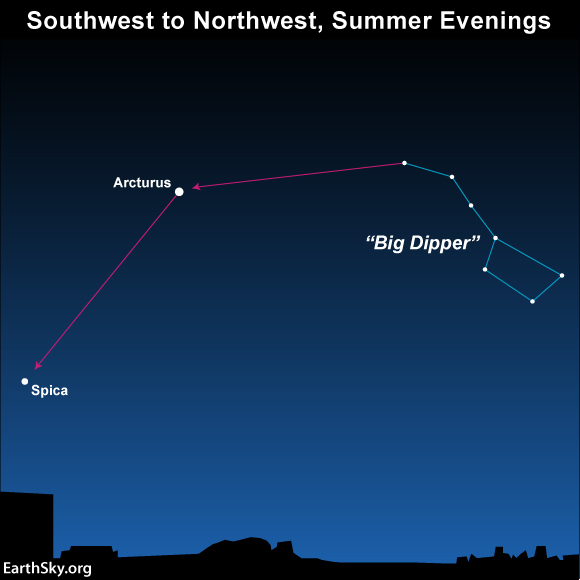
On July 25 and 26, 2020 – as the setting sun closes the curtains on the day, and the darkening skies bring out a myriad of far-off suns – let the moon introduce you to a special star. The bright star close to the moon on these dates is none other than Spica, the sole 1st-magnitude star in the constellation Virgo the Maiden.
The much brighter starlike object in the southeast sky (outside the sky chart at the top of this post) is the giant planet Jupiter. Jupiter, the fifth planet outward from the sun, shines rather close to the ringed planet Saturn.
The sky chart at the top of this post is set for North America. If you live in the Earth’s Eastern Hemisphere, the moon will appear a little farther west of where it does on this chart. If you live in Hawaii, the moon will be offset somewhat in the opposite direction. Also, the moon on the sky chart appears larger than it does in the real sky.
SKY CHART OF ANTARES?
SKY CHART OF JUPITER & SATURN (NEEDS TO BE MADE)
No matter where you live, the moon continually moves eastward in front of the backdrop stars of the zodiac at the rate of about one-half degree per hour. For a convenient measuring stick, the moon’s angular diameter approximates one-half degree of sky. So the moon moves its own diameter eastward per hour or about 13 degrees (26 moon diameters) eastward per day. Look for the moon to snuggle up more closely with Spica as darkness falls on July 9.
When the moon is no longer close to Spica, you might find it helpful to “star-hop” to Spica instead, as shown on the sky chart below:
Enjoying EarthSky so far? Sign up for our free daily newsletter today!

If you live in the Northern Hemisphere, and you’re familiar with the Big Dipper, you can count on this famous pattern of stars to guide you to Spica. Simply extend the Big Dipper handle to arc to the brilliant yellow-orange star Arcturus and then to spike Spica, a blue-white gem of a star. If you have difficulty discerning stellar color with the eye alone, try your luck with binoculars.
Bottom line: Let the moon guide you to Spica on July 25 and 26, 2020, and then use the Big Dipper to locate Virgo’s brightest star, after the moon’s flirtation with Spica ends.
Donate: Your support means the world to us
EarthSky astronomy kits are perfect for beginners. Order today from the EarthSky store
from EarthSky https://ift.tt/327r2e2

On July 25 and 26, 2020 – as the setting sun closes the curtains on the day, and the darkening skies bring out a myriad of far-off suns – let the moon introduce you to a special star. The bright star close to the moon on these dates is none other than Spica, the sole 1st-magnitude star in the constellation Virgo the Maiden.
The much brighter starlike object in the southeast sky (outside the sky chart at the top of this post) is the giant planet Jupiter. Jupiter, the fifth planet outward from the sun, shines rather close to the ringed planet Saturn.
The sky chart at the top of this post is set for North America. If you live in the Earth’s Eastern Hemisphere, the moon will appear a little farther west of where it does on this chart. If you live in Hawaii, the moon will be offset somewhat in the opposite direction. Also, the moon on the sky chart appears larger than it does in the real sky.
SKY CHART OF ANTARES?
SKY CHART OF JUPITER & SATURN (NEEDS TO BE MADE)
No matter where you live, the moon continually moves eastward in front of the backdrop stars of the zodiac at the rate of about one-half degree per hour. For a convenient measuring stick, the moon’s angular diameter approximates one-half degree of sky. So the moon moves its own diameter eastward per hour or about 13 degrees (26 moon diameters) eastward per day. Look for the moon to snuggle up more closely with Spica as darkness falls on July 9.
When the moon is no longer close to Spica, you might find it helpful to “star-hop” to Spica instead, as shown on the sky chart below:
Enjoying EarthSky so far? Sign up for our free daily newsletter today!

If you live in the Northern Hemisphere, and you’re familiar with the Big Dipper, you can count on this famous pattern of stars to guide you to Spica. Simply extend the Big Dipper handle to arc to the brilliant yellow-orange star Arcturus and then to spike Spica, a blue-white gem of a star. If you have difficulty discerning stellar color with the eye alone, try your luck with binoculars.
Bottom line: Let the moon guide you to Spica on July 25 and 26, 2020, and then use the Big Dipper to locate Virgo’s brightest star, after the moon’s flirtation with Spica ends.
Donate: Your support means the world to us
EarthSky astronomy kits are perfect for beginners. Order today from the EarthSky store
from EarthSky https://ift.tt/327r2e2

Aucun commentaire:
Enregistrer un commentaire